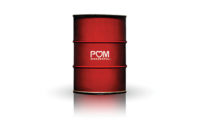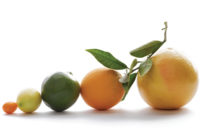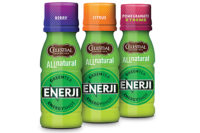In 2010, ready-to-drink (RTD) tea made up 80 percent of the tea category, a 6 percent increase from 2006, according to a May 2011 Packaged Facts report, “Functional and Natural Ready-to-Drink Beverages in the U.S.” The Rockville, Md.-based market research publisher projected that RTD teas would grow 10 percent this year, reaching $6 billion in retail sales by 2015.
RTD tea brands such as Honest Tea and Sweet Leaf are known for using a direct-brew process; however, beverage-makers most commonly use liquid or powder tea extracts to formulate their RTD teas, says Gary Vorsheim, director of extract sales for Martin Bauer Inc., Secaucus, N.J. Tea extracts are easier to work with, more convenient, cleaner and simpler, he adds.
“Even if you buy leaf tea from the same origin from the same garden every year, it will be different because of the seasonality, weather conditions, things of that nature that change the way the leaf is season to season,” Vorsheim says.
Extracts, on the other hand, are manufactured. The extract process starts with brewing tea leaves in hot water, but the similarities end after that, he says. With extracts, manufacturers can remove sedimentation, adjust the astringency and alter the taste profile, if a beverage-maker prefers. And, they offer consistencies in terms of taste, color and clarity, he adds.
John Crandall, vice president of sales for Amelia Bay, Alpharetta, Ga., adds to that, noting that insoluble liquids in a tea beverage offer color, astringency and flavor, but they also change through time. Tea extracts offer a better shelf life, he says. Plus, they offer convenience for beverage-makers. Amelia Bay provides its customers with a drum of tea, which can include flavor if requested. From there, all the beverage-maker needs to do is add water.
Likewise, Flavor Producers Inc.’s Trü Brüz line of tea extracts can be blended with water, sweeteners and other ingredients, says Tony Moore, chief flavorist with the Valencia, Calif.-based company. He also points out that tea products that use the extracts can be labeled as “brewed tea,” which appeals to consumers.
Hamilton, Ohio-based Sensus LLC, which was recently acquired by Wauconda, Ill.-based Synergy Flavors, offers tea distillates and concentrates. The key for Sensus has been to work as quickly as possible in order to get the highest quality product.
“When you take a product and you start processing it, all you can ever do is hurt it, generally,” says Kevin Goodner, director of research and development for Sensus. Therefore, the company separates the aroma, keeping it from further processing. The polyphenol fraction, however, sees multiple steps of filtering out the tea leaves, clarifying the liquid and concentrating it to a high level. After all that, the flavor is added back in. “If all that flavor had been in each of those steps, it would have degraded tremendously,” Goodner says.
Colorful options
In 2010, about 80 percent of tea consumed by Americans was black tea, followed by green tea at just over 19 percent, and a small amount of oolong and white tea took up the remaining share, states the Tea Association of the U.S.A.
“There’s more influence today on green teas because green tea is thought to have more health benefits than other teas and there’s a lot of scientific data to support this,” says John Wilson, marketing and sales coordinator for Edison, N.J.-based Allen Flavors Inc.
By consumption, black tea is still the most popular tea variety; however, from a growth analysis, Walter Postelwait, vice president of sales and marketing for Long Beach, Calif.-based BI Nutraceuticals, believes green tea is No. 1. In the last two years, it’s gained a true foothold as a staple beverage for the American consumer, he says. And other varietals like yerba mate and oolong are gaining in popularity as well, he says.
“They’re all becoming fairly mainstream,” Postelwait says. “Green tea has become a very popular product here in North America in conjunction with yerba mate, [which] now is starting to get introduced, and it’s easy for the developers to work with because of the flavor profile, the solubility is obviously very good, there’s not much sedimentation or fallout associated with tea products or ingredients you use in beverage applications, and then conversely you can use it in a lot of different environments.”
Flavor Producers’ Moore expects green and white tea varietals to continue to gain in popularity because of their higher levels of polyphenols and catechins.
A summer 2011 Packaged Facts survey of 2,000 U.S. adults found that those who drink tea tended to purchase a select few types of tea more heavily with black tea, green tea and herbal tea among the most popular. But several specialty teas are attracting interest; the survey found 10 percent of consumers interested in white tea, 10 percent interested in chai, 9 percent interested in oolong, 5 percent interested in rooibos, and 4 percent interested in mate.
“Black tea is still far and away the most popular tea type here in the United States, in both hot and cold formats, but in recent years more and more consumers have begun to explore specialty types,” says Suzanne Niekrasz, director of marketing communications for Robertet Flavors, Piscataway, N.J. “These include white teas, named for the fine, silvery white hairs from the unopened buds of the tea plant, which are harvested by hand; green teas, which are lightly processed in comparison to black teas; and named varietals, such as oolong.
“In addition,” she continues, “there are a number of other herbal infusions that are closely associated with tea, such as rooibos, a red herbal infusion out of South Africa; yerba mate out of South America; hibiscus, a red floral type; and functional herbal types such as relaxing chamomile.”
While J. Patrick O’Keefe, president of tea extracts supplier Finlay Tea Solutions U.S. Inc., Florham Park, N.J., acknowledges that black tea is the most popular, tried and true variety in the United States, he also calls out the growth of green tea in the West. An increase in studies on the health benefits of green tea is aiding in the variety’s popularity, he says.
“I think in the near term we will see varietal teas like oolong, white and pu’er continue to gain traction, along with specific provenance of tea, for example: Sri Lankan black tea extract or Kenyan black tea extract,” O’Keefe says.
In addition to green and white tea, specialty teas like chai, oolong, rooibos and yerba mate are starting to see some growth. Although they’re still flying under the consumers’ radar, the Tea Association of the U.S.A. says they’ll help contribute to the tea category’s growth during the next few years. The association anticipates strong, continuous growth during the next five years, coming from all segments of the tea category. The ingredient’s success will be driven by convenience, consumers’ interest in the healthy characteristics of tea, and the continued discovery of specialty tea, it states.
Functionali-tea
Because of its healthy connotation, tea is being used in a variety of beverage applications. However, certain beverage categories are more receptive to tea as an ingredient than others.
“Tea consumption in general, and the increasing use of tea as an ingredient or product differentiator outside of the tea category, is being driven by extensive mainstream media attention due to its good-for-you properties,” says Robertet Flavors’ Niekrasz. “It’s an ingredient that consumers understand and that carries positive connotations. The healthy halo surrounding tea is now well-established, and as a result, tea products are being incorporated into a wide variety of product categories.”
Beverage categories, including tea, make use of leaf tea, tea extracts and tea flavors. Robertet Flavors offers spray dried tea powder blends, and for beverage-makers looking for a natural claim, it offers natural tea essences and tea flavors, Niekrasz says.
Postelwait of BI Nutraceuticals, which offers powder tea extracts and tea bag cuts, notes tea’s functional attributes. Consumers are aware of the ingredient’s caffeine content, and some believe that green tea aids in weight loss because of its ability to speed up the body’s metabolism, he says.
“We’re also seeing juice-based beverages start to utilize teas and tea extracts, either to position [the product] as energy or just to have a functional ingredient in their juice,” Postelwait says.
Utilizing the natural caffeine content in tea, many beverage-makers have begun formulating energy drinks and shots with tea. Allen Flavors Inc., which offers multiple tea products and is the U.S. distributor for Nestlé coffee and tea extracts, foresees a continuation in functional teas beyond the initial energy formulation trend, Wilson says.
On the other side of the spectrum, Martin Bauer’s Vorsheim notes consumer interest in relaxation and anti-energy drinks that are primarily blended with green and black tea.
Nevertheless, the health characteristics, flavor and color of tea make it a good candidate for formulation in almost every beverage category.
“The categories of beverages using tea are ever-expanding and include both still and carbonated in myriad flavor combinations and functional beverages including energy, heart health, mental focus and other functional attributes,” Flavor Producers’ Moore says.
Tea trends
According to the Tea Association of the U.S.A., about 85 percent of tea consumed in the United States is iced. While iced tea remains one of America’s favorite types of tea, beverage-makers are getting more innovative in their formulations.
In addition to functional formulations, Flavor Producers’ Moore expects beverage-makers to blend tea with other herbal, floral and spice essences — for instance, black tea combined with a jasmine essence or green tea combined with a ginger essence. Flavor Producers offers a variety of these essences, which have the ability to be labeled “cleanly” in a beverage product’s ingredient statement, Moore explains. This can be a benefit for beverage-makers because consumers are seeking beverages with simple ingredient statements, according to Amelia Bay’s Crandall. He notes that the Top 3 tea-related product trends he’s seeing are 100 percent natural beverages, functional products that do more than simply refresh consumers, and the word “brewed” on a tea drink’s label.
But above all, consumers are looking for great taste, says Finlay Tea Solutions’ O’Keefe.
“A great-tasting beverage is the single largest driver in consumers’ preferences,” he says. “There [also] is a growing consumer segment that is attracted to tea that can be identified with a specific tea-growing region. Organic and Fair Trade definitely have their place in the market, but Rainforest Alliance teas seem to be a big trend at the moment.”
Martin Bauer’s Vorsheim agrees, adding: “Along with the trend of health and wellness, people are also interested in having the beverages that they drink provide a positive impact on the world. By buying a tea that indicates that it’s certified, [like] Rainforest [Alliance certified], that does seem to be something that is becoming more popular as far as a trend on the packaging that consumers are identifying.”
On the health-associated side, many beverage-makers are looking to capitalize on the polyphenols in tea. Amelia Bay has the ability to standardize those levels so that a beverage could claim a specific amount of polyphenols per serving, Amelia Bay’s Crandall says. Additionally, the company sees growing demand for omega-3 fatty acids in tea products. The company offers an algae-derived addition that imparts no flavor and little color, Crandall says.
In 2012, he expects to see more growth in functional beverage line extensions, such as tea-based sports drinks and tea-based vitamin-enhanced waters.
Black tea with lemon continues to be a popular combination; however, multiple tea extract suppliers are noticing that within the last few years, companies have started to develop hybrid tea-with-lemonade beverages.
“Consumers like to express their individuality, and flavored lemonade with iced tea combos offer plenty of opportunities to deliver on that desire,” says Robertet Flavors’ Niekrasz. “It’s something a little new, a little different, yet with broad mainstream appeal. The tea-with-lemonade category is ripe for further launches when you consider the many combinations of flavors, sweetness levels, juice levels and added-value functional ingredients that can be explored as product differentiators. There are also new formats that have just begun to emerge, such as sparkling tea lemonades.”
Tea doesn’t only pair well with lemon or lemonade. Ingredient suppliers note that it’s an easy flavor to pair with many fruit flavors. Sensus’ Goodner sees a lot of customers requesting standard flavors, such as lemon, raspberry and peach, in addition to superfruit flavors, like acai and pomegranate. He also points out that dragon fruit seems to be gaining in popularity, along with mango and mint flavors. Generally speaking though, sweet and plain teas are the biggest sellers, he says.
Flavor blends also are becoming more popular, according to Allen Flavors’ Wilson. The company has received requests for teas infused with both flavors and spices, such as tangerine cinnamon, he says. He also expects to see some new floral and herbal infusions with white teas to complement the variety’s delicate taste.
Beverage-makers also are becoming more focused on enhancing the tea flavor in their drinks, Vorsheim says. Whether they’re using more tea in their products or using a higher quality tea, they’re working to impart more tea flavor into their beverages — even if that means taking out some sugar — because that’s what consumers are seeking. They’re also not interested in seeing “caramel color” listed on the ingredient label, Vorsheim says. Therefore, some beverage-makers will use alternative methods to maintain the product’s color, or the tea will simply become lighter in color, which appears more natural, he adds.
For the foreseeable future, the tea category will continue its growth streak with emphasis on ways to differentiate tea-infused beverages in the marketplace, he says. This may include reduced-calorie options, such as growth in unsweetened and lightly sweetened RTD teas; new flavor options; and blends of tea varietals, experts say. BI








